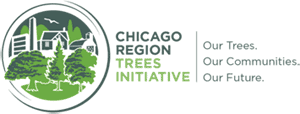Lydia Scott logged more than 600 miles in her hybrid SUV last year, identifying tree species, measuring them and estimating their maturity on green patches from Chicago's South Side to far-flung Harvard.
She is both foot soldier and field general in the most comprehensive tree census of any large U.S. metropolitan area. The review, which also used aerial laser scanning, found that more than 157 million trees are growing in the seven-county Chicago region, a number that translates to about 21 percent of the area covered in trees and shrubs — well below the national average of 27 percent.
All that counting and cataloging reveal a somewhat bleak past for woody plants in the region, which is emerging from the emerald ash borer scourge that experts say will have wiped out 13 million trees by the time it moves downstate. Adding to that devastation is the European buckthorn — the area's most dominant tree, accounting for nearly 30 percent of all species — an invasive plant that shoves out the state's native oak.
The hope is that the specifics of that distressing picture can provide insights for an unprecedented campaign to turn around history. It's called the Chicago Region Trees Initiative, and the goal is to add more woody plants and keep them healthy — no matter what threats descend on northeast Illinois.
Scott, a former assistant public works director, is the campaign's executive director.
"It's more than trees," she said one afternoon at Morton Arboretum, the lead organization of the effort and where Scott works as the community trees program manager. "It's really quality of life. You go back to what you learn in grade school about nature as a web. One community is going to impact another community and on around. By working together, we can have a more collective impact."
Exactly how the tree initiative will accomplish its goal comes down to a network of 13 lead partners — including the arboretum, the Forest Preserve District of Cook County, The Nature Conservancy, U.S. Forest Service, Openlands and the Landscape Contractors Association. Overall, almost 200 entities have signed up as partners, Scott said.
The initiative has established eight work groups responsible for gathering and crunching data to find more places to plant trees, training public employees and private citizens in forestry and tree stewardship, promoting the campaign and raising money. At the heart of the effort is planting trees to restore the urban and suburban forests in Cook, DuPage, Kane, Kendall, Lake, McHenry and Will counties.
Since its launch in 2013, the Chicago Region Trees Initiative has staffed its work groups and begun offering training. It also has obtained a $400,000 U.S. Forest Service grant, in addition to Morton Arboretum's estimated $400,000 seed money contribution and a $30,000 grant from Bank of America.
"We apply for anything we can find," Scott said, adding that the initiative is "starting to show a track record" it can take to larger potential benefactors in the Chicago area. The collective's size also will carry influence across the U.S., she said.
"We're hoping that we'll be able to go to some national funders to say that we're really establishing a whole new paradigm for how you think about the urban forest," Scott said.
Most municipalities are supportive, Scott said, although one that she declined to name has opted out because it prohibits trees on public property and relies on residents to plant their own. In addition, some town foresters have said they simply don't have the time to devote to the initiative's training and related programs, Scott said.
Funding is another hurdle, Scott said, as municipalities deal with tight budgets lingering from the recession and the expense of fighting the emerald ash borer. Another challenge is a shortage of trees. When the ash borer prompted towns to devote most of their forestry resources to cutting down ash trees, nurseries were left with trees without buyers and destroyed much of the inventory that was too mature to transplant. Now, as towns look to buy trees, nurseries are still trying to catch up with demand.
Scott continues to criss-cross the metro area to garner support. She has met with Illinois State Toll Highway Authority officials to talk about planting trees on back slopes of road corridors, and representatives from Catholic Charities to discuss planting more trees in cemeteries.
The working-class south suburb of Blue Island is one municipality that has jumped onboard. On Saturday, six days before Arbor Day, the initiative used part of its Bank of America grant to plant trees on Canal Street. The bulk of that money will fund tree plantings along Western Avenue in the future, Scott said.
A few days earlier, Scott gave a presentation at a Blue Island Chamber of Commerce breakfast and found a convert. Her name is Peggy Walsh and she has lived in town for nearly four decades. She said she would love for Scott's plans to become reality.
"I look into Blue Island from other communities and I see a desert," Walsh said after the meeting at the City Hall annex. "The air looks dirty. Why is that? There's not enough trees. When you're around trees, it just feels clean. It just feels fresh. It just feels like home."
About 70 miles north is another tree apostle, Laura Bover, an administrative assistant in the Round Lake Public Works Department.
Watching dead ash trees that "looked like sticks" be replaced with new trees in a Round Lake subdivision a few years ago was a transformational experience for her.
She became a tree activist and last fall took a class — that Scott taught in part — to earn her certification as a tree keeper through Openlands. Now Bover is planning to create a volunteer tree-keeping program in the village.
"A little bit at a time, and you can do it," she said. "The important thing is that you start."
Twitter @tgregoryreports
